
SANTA FE
|
Santa Fe is very interesting for many reasons. It is a small town of just under 15000 inhabitants, located in the province of Granada. It is only a little more than six miles east of the city of Granada, which is also the capital of the province.
|
|
Santa Fe is also home to the airport, which serves both Granada and Jaen to the North.
The history of the city dates back to the Middle Ages. When most of it disappeared in a fire in the mid-1480s, the Catholic kings, Fernando and Isabel, decided to set up a military camp there, which would help in the siege of Granada. This happened around 1490. The objective was to drive out the last Moors from the Iberian Peninsula, which succeeded in 1492, that is, in the same year, as Columbus believed himself to have managed to find the back route to India.
This military camp was laid out with two main streets in an almost square floor plan. At the four end points, defensive gates were built, which remain today, although they have changed significantly. In today's city, the area of this military camp is called "Real de Santa Fe", roughly "Royal Santa Fe". Because, of course, today's society has grown considerably outside the old walls. However, the gates have retained their old names. They got these after the most significant city in the direction, to which they led. To the East, as already mentioned, is Granada, therefore the eastern gate is also called Puerta de Granada. Jaen is located in the north, while the gate is logically called Puerta de Jaen. The southern one led to Seville and the Western one to Cordoba, although in recent years the latter has been renamed to Puerta de Loja, which is a good distance closer than Cordoba.
|
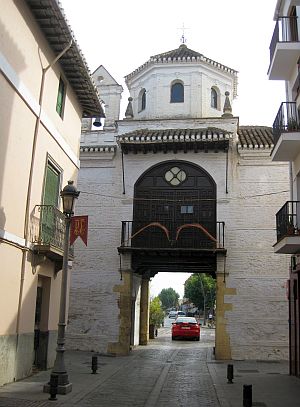
Puerta de Granada |
|
Although - the name is probably the only thing that reminds of the old Gates. They have been destroyed by an earthquake, been demolished and rebuilt and the like. That is why at best the external shape of the gates remind of ancient times. However, all of them have two floors and a hexagonal tower.
|
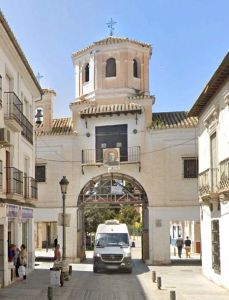 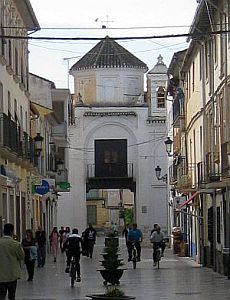 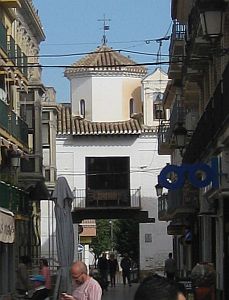
Puerta de Loja Puerta de Sevilla Puerta de Jaen
When the gates were no longer needed as defensive structures, the upper floor was given other tasks. In the Puerta de Granada, as well as in the Puerta de Jaen, there are small chapels or places of worship. In addition, the tourist office is located in one gate, a shop and an apartment in another.
The photos on the right and below are taken from the Puerta de Granada, but I have a problem with the dome.
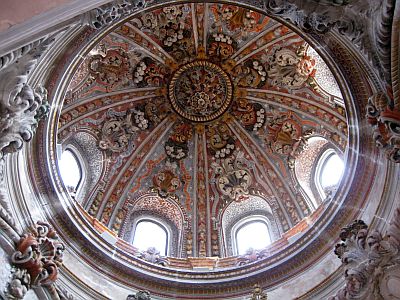
|
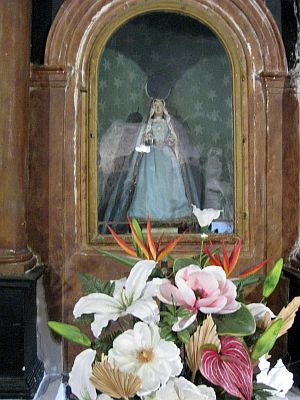 |
|
There are eight windows there, but as everyone can see, the tower is just a hexagon with six windows, as with all the other gates. I didn't notice it until I got home, but I took the pictures myself. It must be an architectural marvel.
|
In the Puerta de Jaen there is another oddity, to which, however, I received an explanation. There is a completely normal staircase in the entrance to the tower. But to the left of it is one with much smaller steps. The explanation is a little scary in my eyes, but it is nevertheless true. The left part of the stairs is for people who want to climb up on their knees ...
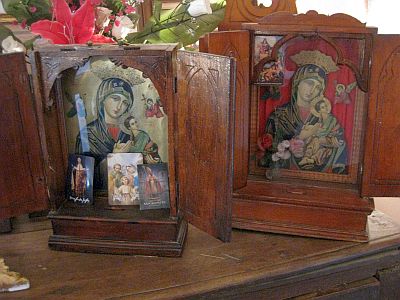
|
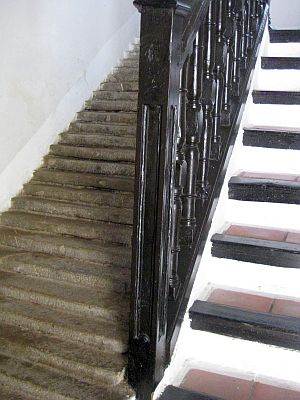 |
The explanation for the picture above is less cruel. These are so-called House altars, of a kind that one could set up at home, to create a corner of devotion.
But enough about the gates and their contents, although I find the concept quite appealing, both in the past and in the present.
At the intersection of the main streets there is the Square and there is the church, in the middle of the village, so to speak.
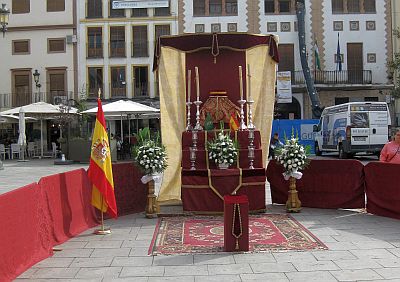
|
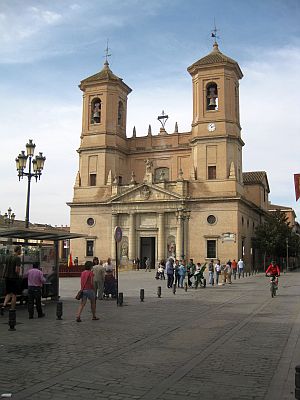 |
|
Outside, opposite the church, a small stage had been built. There, after the divine service, one would pay tribute to the memory of Columbus's arrival in America. There were some people coming to watch, but we preferred to enjoy it all from a cafe with outdoor seating. People around us discussed the pros and cons of such memorable moments. The general attitude seemed to be that there was nothing wrong with Memorial moments, if they were not exploited by far-right people and even parties, to incite the crowd to an overheated nationalism, with all that that entails.
|
|
But now let's look at another part of the historical background, which Santa Fe stands for. It was here, in the old military camp, that two world historical events took place. Moreover, in quick succession. The first of them happened on november 25, 1491. That was the capitulation of Granada, signed here between the Catholic kings and Boabdil, the last Sultan of Granada. The conditions were very humane, not at least in religious matters, both for Muslims and Jews. Granada was then surrendered in the first days of 1492. However, the good conditions quickly changed, when a certain Cisnero became archbishop of Granada, as he immediately began to make life difficult for non-Christians.
|
|
The second, if possible even larger world event, was agreed on, just short of six months later, in the same place. It was on april 17, 1492, that the treaty between Columbus and the Catholic kings was signed. Funnily enough, in Spanish it is also called "capitulaciones", which may seem a bit haughty, since there was no one yet who could capitulate anything. But that's not the case, of course. It is called "capitulacion", because the scripture is divided into "capitulos", that is, chapters. On the right is a transcript of this treaty, which it by defnition really is.
|
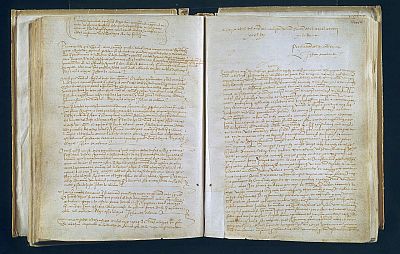 |
On the wall on the right it says "in this place the treaty (capitulaciones) was signed between the Catholic kings and Christopher Columbus.
The fact, that Columbus was not very modest, is clear from the terms of the agreement. First, he was to become a Naval Admiral, then Vice-King of the conquered territories, as well as governor-general over them. In addition, he was to receive the honorary title "Don" to his name and, finally, a tenth of the value of the conquered treasures. It is perhaps not so strange that he got his wishes through only in the third attempt, when the Kings had come to the realization that they really did not have much to lose by agreeing to the demands.
|
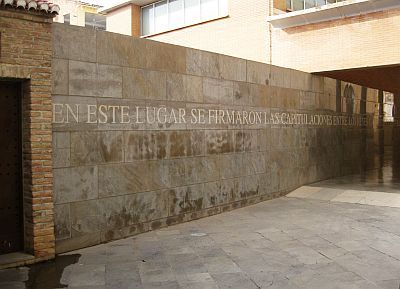 |
Eventually, however, there were discussions about the terms, which lasted until long after the death of those involved.
At the same time as his audacity, one must admire the courage of Columbus, to set off on an expedition, which everyone claimed could not succeed, since the undertaking was impossible. Columbus must have had a decent amount of self-confidence. He started his journey on the third of August, so he had three and a half months to prepare. He landed more than two months later with his three ships, the Niņa, the Pinta and the Santa Maria.
Adjacent to the wall with the inscription is also a museum, run by the Institute of America and which displays archaeological finds of Native American origin. But partly I have seen better museums, partly the art is concentrated on Mayan finds, like the one on the right in the picture.
Copyright Bernhard Kauntz, Västerås 2022
|
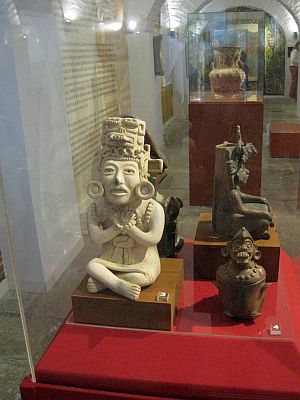 |
Back to  ,
or to the ,
or to the  of of 
page constructed on: 24.11.2022 by webmaster@werbeka.com
|

